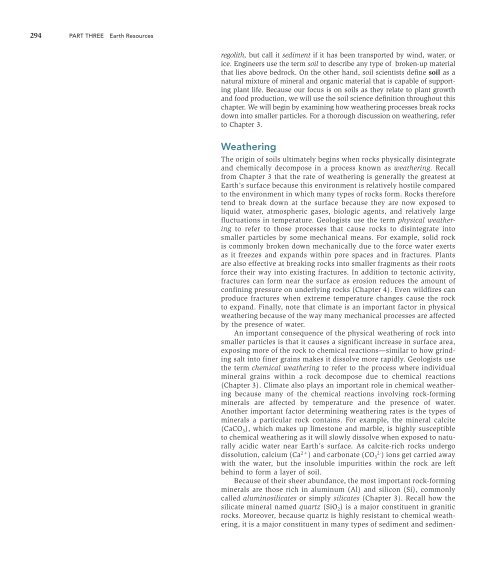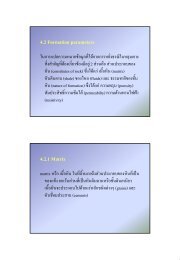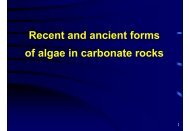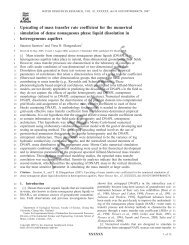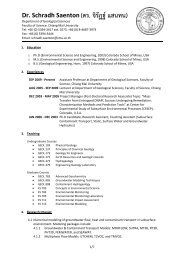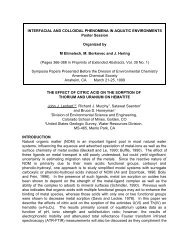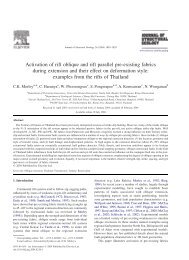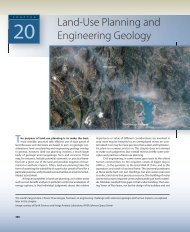Soil Resources - Geological Sciences, CMU
Soil Resources - Geological Sciences, CMU
Soil Resources - Geological Sciences, CMU
Create successful ePaper yourself
Turn your PDF publications into a flip-book with our unique Google optimized e-Paper software.
294 PART THREE Earth <strong>Resources</strong>regolith, but call it sediment if it has been transported by wind, water, orice. Engineers use the term soil to describe any type of broken-up materialthat lies above bedrock. On the other hand, soil scientists define soil as anatural mixture of mineral and organic material that is capable of supportingplant life. Because our focus is on soils as they relate to plant growthand food production, we will use the soil science definition throughout thischapter. We will begin by examining how weathering processes break rocksdown into smaller particles. For a thorough discussion on weathering, referto Chapter 3.WeatheringThe origin of soils ultimately begins when rocks physically disintegrateand chemically decompose in a process known as weathering. Recallfrom Chapter 3 that the rate of weathering is generally the greatest atEarth’s surface because this environment is relatively hostile comparedto the environment in which many types of rocks form. Rocks thereforetend to break down at the surface because they are now exposed toliquid water, atmospheric gases, biologic agents, and relatively largefluctuations in temperature. Geologists use the term physical weatheringto refer to those processes that cause rocks to disintegrate intosmaller particles by some mechanical means. For example, solid rockis commonly broken down mechanically due to the force water exertsas it freezes and expands within pore spaces and in fractures. Plantsare also effective at breaking rocks into smaller fragments as their rootsforce their way into existing fractures. In addition to tectonic activity,fractures can form near the surface as erosion reduces the amount ofconfining pressure on underlying rocks (Chapter 4). Even wildfires canproduce fractures when extreme temperature changes cause the rockto expand. Finally, note that climate is an important factor in physicalweathering because of the way many mechanical processes are affectedby the presence of water.An important consequence of the physical weathering of rock intosmaller particles is that it causes a significant increase in surface area,exposing more of the rock to chemical reactions—similar to how grindingsalt into finer grains makes it dissolve more rapidly. Geologists usethe term chemical weathering to refer to the process where individualmineral grains within a rock decompose due to chemical reactions(Chapter 3). Climate also plays an important role in chemical weatheringbecause many of the chemical reactions involving rock-formingminerals are affected by temperature and the presence of water.Another important factor determining weathering rates is the types ofminerals a particular rock contains. For example, the mineral calcite(CaCO 3 ), which makes up limestone and marble, is highly susceptibleto chemical weathering as it will slowly dissolve when exposed to naturallyacidic water near Earth’s surface. As calcite-rich rocks undergodissolution, calcium (Ca 2+ ) and carbonate (CO 32-) ions get carried awaywith the water, but the insoluble impurities within the rock are leftbehind to form a layer of soil.Because of their sheer abundance, the most important rock-formingminerals are those rich in aluminum (Al) and silicon (Si), commonlycalled aluminosilicates or simply silicates (Chapter 3). Recall how thesilicate mineral named quartz (SiO 2 ) is a major constituent in graniticrocks. Moreover, because quartz is highly resistant to chemical weathering,it is a major constituent in many types of sediment and sedimen-


